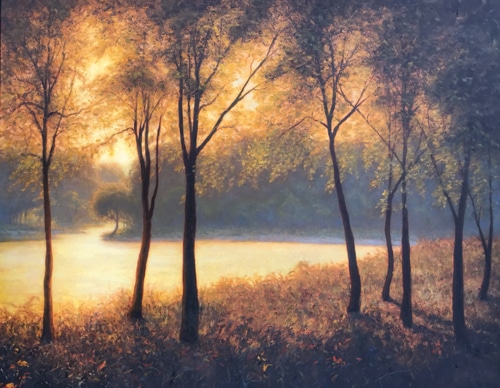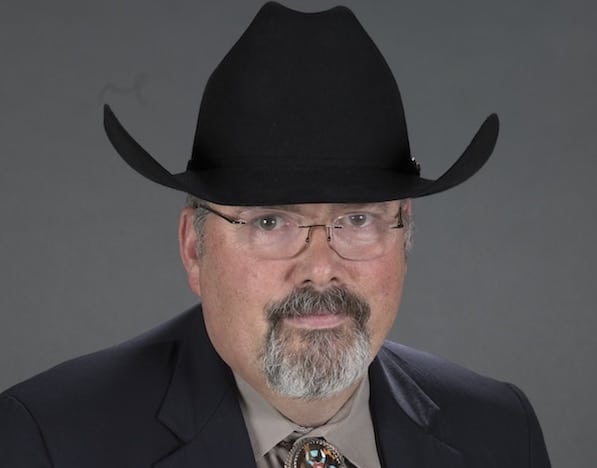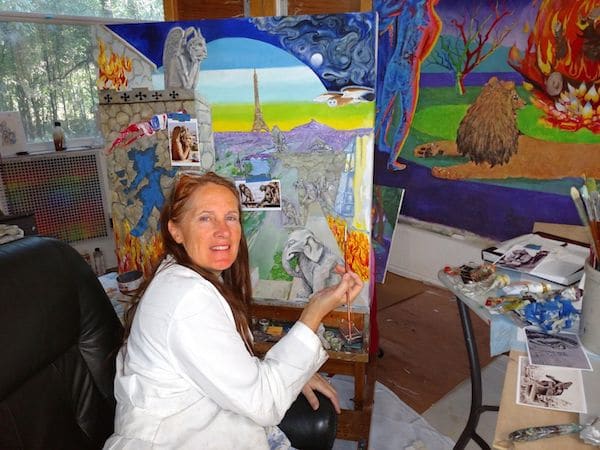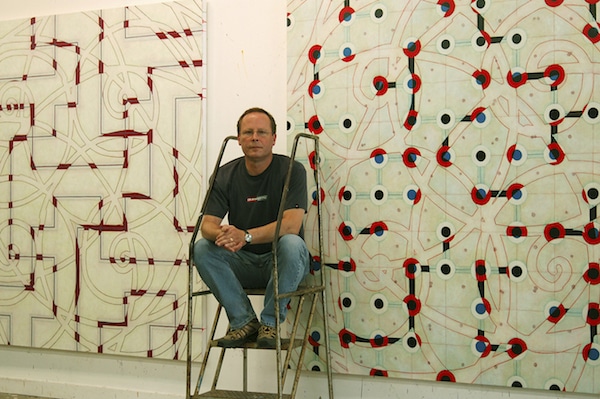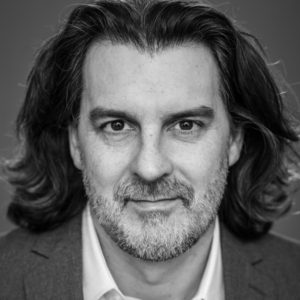 2017 Accelerator Fellow
2017 Accelerator Fellow
Where did you grow up?
Madison, Wisconsin.
When/how did you first know that you wanted to be an artist?
I was certain of my identity as an artist by the age of five. It was also clear to me that I preferred 3-D media.
Where do you currently live/work, and how would you describe the arts community there?
I currently live in Madison, Wisconsin, where we have a small but very exciting arts scene. For example, the Dane County arts board is experimenting with promoting a business-to-business event called “Dane Arts Buy Local.” This is a singular event that is very pro-artist. Instead of charging upfront fees, they only ask for a small commission. I appreciate this shared-risk approach, which is very uncommon. The Bubbler is another innovative project that has received national attention, incorporating art exhibitions into the city’s public library system.
There are also a lot of homegrown and alternative events/doings. In my own neighborhood, there is a small group of artists that works together informally on various projects, including group shows, private commissions, and a sculptural gateway for the neighborhood.
The gallery scene is limited these days. In terms of collectors, the main local player is Epic Systems, a healthcare company whose representatives frequent area art shows. Unfortunately, the weakness of the art economy has forced me to look beyond our community for revenue. On the plus side, Artful Home, a reputable national online gallery, is based in Madison; I see a lot of potential in my relationship with them.
How would you describe your art to someone who’s never seen it?
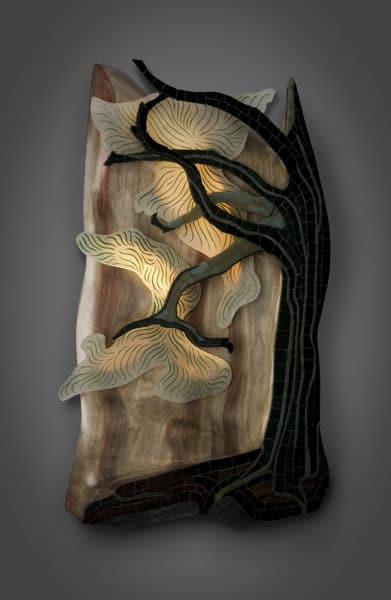
I view what I make as sculpture—especially the more functional pieces. I work predominantly in wood, and also employ other mixed media such as glass, stone, bark, paper, and metal. My inspiration comes from the desire to interpret the mysteries of life and nature, and to express the emotions and impressions that these mysteries evoke. I do this through organic and abstract forms that display a sense of movement and harmony. To achieve this result, I focus on the composition and seek to create a balance of materials, textures, and colors that truly “ring,” like a chord played perfectly in tune. I frequently experiment with new materials and combinations, but I have also been developing several recurring themes and series over the years.
What do you hope to communicate to your audience?
As an abstract artist, it is not as important to me that the viewer understand the intention behind a specific artwork as it is that the piece evoke some memory or sentiment in that viewer’s own mind, or perhaps even spark creative thought. Of course my work won’t speak to everyone, but for those who respond to it, I also hope that my focus on composition and balance translates into a sense of peace and calm in their built environments. My tagline is “to live with art is to live well”; this heartfelt sales pitch underscores my focus on harmonious elements in the universe, which I view as rare events that are worthy of illumination.
What’s been your biggest business challenge?
Right now, I am struggling to find a balance between my expenses, income, and time spent away from home. One of my goals is to find higher-end clients who can pay what my work is really worth. I definitely need to generate more income and make changes to my marketing strategy.
Tell us about a business success and what you did to achieve it.
I recently found someone to help me with my social-media presence. Outsourcing this task has dramatically improved my quality of life since I don’t know anything about social media and have an irrational distaste for it. This decision has allowed me to focus on other things and finish commissions that had been piling up.
How do you feel about today’s technology (tools for your business, for creating your art, or both), and has it altered your way of doing business?
I never would have imagined people spending real money on art that they have only seen on the Internet. I am very hopeful about increasing my online sales.
What do you think about the state of today’s art market?
It may be thriving somewhere, but in my experience, it is in a catastrophic state, especially this year; even the low-end buyers seem to have no money to spend. I am not sure what to do next. The millennial generation appears to be the new target audience, but they are difficult for me to read. There is so much in flux that it’s hard to keep pace with the changes.
Give us an example of how you balance studio time with business time.
Not as well as I would like. Usually, I end up dropping one or the other depending on the demands of the moment, though I try to do a little of each every day. I work from home, which I prefer, so it is not so difficult to switch tasks.
How have you evolved as an artist?
Since my first awakening as an artist at the age of five, I have had various perspectives on it. This includes moments of disillusionment and distance from the notion of “fine art.” The act of creative thought is what truly drives me.
During my junior year of college, I spent a year in Hyderabad, India, which was a transformative experience that initiated my separation from the art that I was being taught to make at the university. At the time, I no longer felt that making art connected me to some greater force in the universe. Instead, I saw it as an intellectually tepid and self-indulgent act. In order to seek something of substance that would rekindle a more spiritual expression, I endeavored to learn about our common Stone-Age ancestors, and how they survived and made art using only the resources in their natural environment. This was a kind of reboot for me. It compelled me for nearly ten years, as I attempted to live off the land, making stone tools and leather, and learned by doing and immersing myself in the experience of survival—which in my opinion is a true test of the creative mind.
At the same time, I was very lucky to apprentice with my mentor, Steve Spiro, who is a woodworker and artist. I have always felt an innate connection to wood as a material. One thing they don’t tell you when you are young is that what you learn then will very likely define who you are as an older person. Fortunately for me, I mastered the skill of woodworking, which is my chosen medium, and I still love it. Now, at the age of 44, I have finally come full circle; I have a family and am working as a professional artist, creating works of fine art, including many that are functional. It is this functional art that harkens back to my days living in a yurt and practicing Neolithic skills. I had the realization that any mundane object could be infused with art and become as meaningful and deep as the masterworks of a famous artist.

How have you evolved as an entrepreneur?
In my younger days, I was very idealistic, a seeker. I didn’t particularly care if I succeeded. With age and a family, of course, that has changed. Now, I have a much thicker skin and am willing to “play the game” in order to thrive. I am always looking for ways that I can leverage my successes. I was once given some great advice: take success where you find it. Combining this kind of opportunism with a guiding purpose can be an effective route for an entrepreneur.
What role do artists play in our society? What role SHOULD they play?
Most people consider artists to be creative thinkers primarily. Their outside-the-box outlook leads to all sorts of innovative solutions and is crucial in any society that wishes to be vibrant and adaptable. My view is that art is an essential and primal aspect of human existence—like language or the instinct to live in groups—and it is also a fundamentally positive act. As far as the role that artists “should” play, I am not willing to judge. Naturally, I would love to see more respect for artists, and their inclusion in real decision-making processes, but that seems like a pipe dream.
Anything else you would like us to know?
Something that is important to me is the idea of fair business practices. It is considered acceptable to go to a corporate job and screw others all day long, then come home and be caring and loving towards your family. I don’t get it. How does that not make you a jerk?
I am compelled by “buy local” movements and the idea of mutually beneficial relationships as a way of supporting small businesses and the environment. I often wonder if these local movements could be applied to art as well.
For more information on Aaron Laux, see his official CHF bio.



